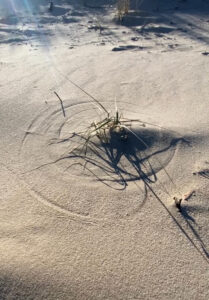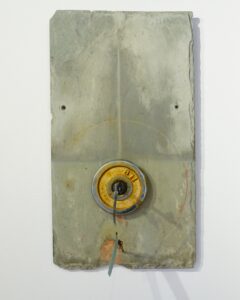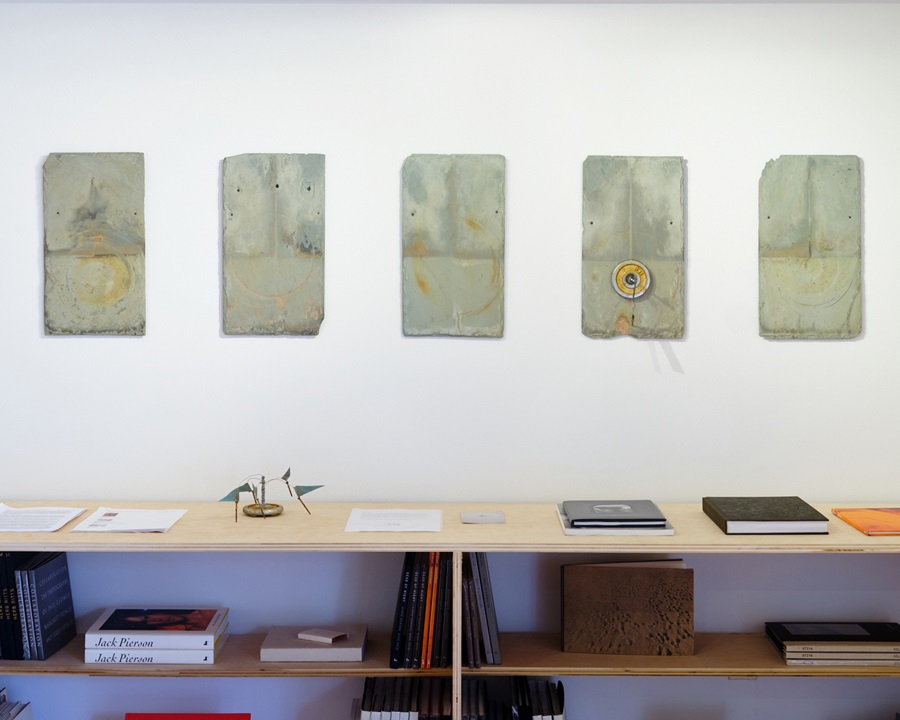We stood on the steps of the dune shack, chipped enamel cups full of strong coffee in our hands, and looked out over a world made clean and new. The footprints we left in the sand in the days before, records of our coming and going, were buried and smoothed over. The tumbling and skipping of grains of quartz and feldspar had filled our steps like windblown snow.
I had waited for this chance to be in the dunes to think and write and live in a shack for a week with my partner, Eli, as if in some simpler time. A wind had been blowing off the ocean and through the hollows of the Province Lands for days when we got there. And all through the night it whipped, spraying the seaward side of the shack in sharp, sand-filled gusts. The pounding woke us and kept us restless and tight-chested until dawn. Out in the dunes, all the world, its rawness, beauty, and indifference, feels close to the skin.

The morning was still. The wind had calmed to a light breeze, its fit had passed, its discontent blown out. Now it rested. We stepped from the wood stairs onto the smooth sand and walked to the beach, past the gap in the snow fence with its twisted wire ends that grab at your shirt, down the little dune, and to a trail nestled into a broad sandy valley edged with heathers, beach plums, and dune grass.
We saw no other signs of steps in the sand. No human footprints, no winding snake’s path, no lobed paw prints of the fox. No living thing had left its mark yet today. Except one. Around each clump of dune grass, drawn in a clean line in the new sand, was a perfect circle.
I’ve always called these marks grass compasses. But they are also known as scratch circles, and they appear on coastlines throughout the world, wherever there is sand, grass, and wind. Scharrkreis, a German word meaning “scrape circles,” is a term that archaeologists use to refer to versions left in sediment and discovered in the geological record dating as far back as the Precambrian.

In the dunes, with time and space to sink deep into my fascination with these compasses, I would lie on my stomach on the sand, chin resting on my hands, and watch them form, one gentle breath of wind, one trembling blade, one grain of sand at a time. The wind, a subtle energy, comes down and moves through the dunes. The grass, a sensitive living instrument, responds. Its blades sway, pivoting from the central point of the stem, sweeping in little starts and broad, graceful arcs, turning like the needle and chisel points of a drawing compass. The tip of the blade brushes gently over the forgiving medium, and in a slow, patient, creative process, the sand yields to the sweeping of the grass, becoming a canvas for the process, telling the story of its own creation.
After we left the dunes, the circles remained in my mind, and I set about finding a way to recreate them.
I built a series of little apparatuses intended to act like clumps of beachgrass. They started simple, became more complex, and then, guided by nature’s designs, returned to simplicity. I used a weighted base and incorporated wheel bearings, an upright bolt for a stalk, steel wires as blades of grass, copper sails to feel the wind, and heavy nails fastened to the wire tips.

These models needed to be sensitive enough to feel a light breeze and sturdy enough to last the winter, because the plan was to set them out in the dunes closer to home in Wellfleet. In October, Eli and I carried them out to Newcomb Hollow Beach, set them on old slate roof tiles that would bear the mark of the blades’ movements, and left them to sit until April. They lasted through winter storms and spring nor’easters, turning in the wind, inscribing circles in the stone.
I don’t know why I felt compelled to recreate these stories of the wind, the grass, and the sand, but it seems I was not the first one to do it. Archaeologists working in South Africa believe that a recently discovered batch of Scharrkreis fossils there, 100,000 years old, might have been made by early hominids. They would have observed sedge grasses drawing circles and, in a moment of inspiration, felt compelled to recreate them. If this is true, those scratch-circle fossils would be some of the earliest evidence of our human ancestors depicting prehistoric life. Early humans, sensitive observers, telling a story, making art.
A collection of Kai Potter’s “On the Landscape” columns was published this year by Provincetown Independent Books. See shop.provincetownindependent.org.



